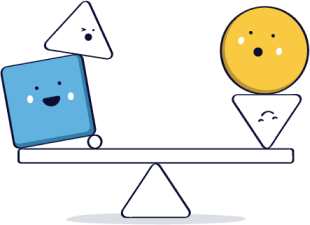
One of the most essential elements of a successful sales process is picking the right sales stages for your sales style. Building a structured pipeline from a proven sales process template is an ideal way to ensure those stages serve your goal of converting leads to sales.
Whether you’re building your first pipeline from scratch or want to overhaul an existing process, having a structured sales process to follow could make all the difference. Keep reading for B2B sales examples and process templates.
This 28-page PDF includes sales process templates for numerous B2B sales models including outbound, inbound, account-based sales, and customer-nurturing sales. Whether you’re adjusting your current process or creating an entirely new one, these sales process templates are a great place to start.

A sales process is a series of repeatable steps a sales team takes to convert prospects into customers. A standardized sales process provides sales reps with a framework to follow, helping them win more deals.
With a structured sales process in place, your team has a definitive plan to guide them through the stages. It’s a great way to ensure all your sales reps are on the same page, regardless of how much experience they have.
In fact, in a world where sales departments typically experience significant staff turnover rates, your defined sales framework makes for easier onboarding.
A comprehensive and well-considered sales process creates consistency, not only for your team but for your prospects, too. This planned approach encourages better prospect experiences and makes sales forecasting easier.
When a system like this is in place, you empower your team members to take responsibility for tasks and activities. As a result, you’ll find communication and efficiency increase, along with your conversion rate and revenue.
It’s important to note that building an effective sales process requires constant evaluation and adaptation to remain relevant.
Review the steps in your process and their role in the overall strategy. Then, make the adjustments you feel are necessary to help your team stay on top.
Providing a framework for your sales team through a documented sales process provides numerous benefits, such as:
When your sales team has a structure to follow, they’ll spend less time and effort deciding what to do next to move a potential deal forward. Determining which leads are most likely to convert and deserve the most attention also becomes easier.
When you have a standardized process, you can more easily track the effectiveness of each step and refine your process to improve your results.
When new sales representatives have a documented process they can follow, onboarding is a smoother process and new team members can start getting results more quickly.
With a more efficient process, your team will likely get a lot more done, such as prospecting, qualifying leads, and contacting prospects. These should see your business enjoy an increase in conversions and revenue.
As your sales team follows the same system each time they move a prospect through the sales pipeline, you’ll experience less confusion and fewer errors. Team members will quickly learn and understand exactly what they need to do as they move from one stage to the next.

Join 30,000+ other sales and marketing professionals in signing up for our free Sell to Win newsletter!
One factor that affects the stages in your sales process is whether you’re running a business-to-business (B2B) or business-to-consumer (B2C) company.
B2B companies sell to other businesses, while B2C companies sell to individual consumers. Some B2B sales examples include selling office supplies, professional services, or business software. B2C sales include the various goods and services individuals purchase every day from groceries to cars to lawncare.
Since these two types of companies sell to different types of customers, there are significant differences in the sales processes. B2B sales processes tend to have:
You’ll find that sales process templates are either generalized or crafted for a specific sales approach. Either way, you must know all the possible sales pipeline stages of typical sales processes when choosing a sales process template or building a system from the ground up.
Naturally, you’ll be familiar with most of these steps and have experienced many of them first-hand. But it’s good to run through them before building a sales process to help you visualize the customer journey and touchpoints.
Remember to make stage and task responsibilities clear with each step, especially when more than one team is involved.
The research phase of the process involves scouting for potential leads and putting a list together for your sales team to contact. There are so many ways to capture leads online, including via social media or through forms on landing pages.
Leveraging website and content optimization can increase your chances of attracting website traffic and securing the right leads for your business. Working with an expert SEO partner to ensure your content strategy is at its best will go a long way to broadening your lead base.
Online forums, groups, and business-oriented platforms like LinkedIn are great places to find potential leads. Networking at trade shows and events is also highly effective and lets you develop a rapport with prospects.
Bear in mind that at this stage of the process, prospects may simply be investigating their options and haven’t considered a purchase.
Ensure that the needs of those on your prospects list align with the products and services you offer. There’s no point in nurturing a lead with zero need or capacity for your offering.
Ask yourself whether your product or service falls within a price range they could afford and if it will bring value to their business. Now is an excellent time to consult your ideal customer profiles and see if your prospects fit the mold.
Many companies have succeeded with a formal lead qualification system within their sales department. Setting up a system to monitor progress throughout the qualification process gives you valuable insights for future qualifying procedures.
The qualification process may even require a quick discovery call to the prospect, relevant company, or department to ask a few questions and provide more insight.
In fact, this stage can sometimes become an avenue for defining needs for both your sales team and the prospect.
This stage involves reaching out to your prospect to introduce your company and product or service.
Your team could contact qualified leads via email, social media, cold call, or speak to them in person. It all depends on the nature of your business, the type of prospect, and where you found the lead.
Consider that this stage may involve multiple outreach attempts, scheduling meetings or calls, and ensuring that decision-makers and relevant roleplayers join the meeting or call.
By this stage, you know that your prospect is a good fit for your product or service and may have a basic understanding of their needs. But every business faces unique challenges, and it’s important to examine these pain points.
You could opt to have your sales team members call, email, or survey prospects to pose targeted questions and get to the crux of their situation.
Bear in mind that your team will need some time to develop a relevant list of questions to get the necessary answers.
Comprehensive query lists may warrant a meeting or call with the prospect. Responses to questions sent via email or survey may be delayed, depending on how much time your prospect has available.
Your sales team should pose questions to decision-makers and stakeholders that have a say when deciding. If their first point of contact leaves them looking for someone else with decision-making authority, your process should leave some leeway for this delay.
When your team has established the prospect’s pain points and how to resolve them, it’s time to deliver the pitch. The pitch is where your team showcases a solution to meet the prospect’s needs.
The pitch may include a demo or free trial, which lets the lead sample the product before purchasing. Most pitches comprise a pitch deck presentation, for which you may have a sales process template.
Regardless, this sales process step must allow for pitch preparation, which may include recreating the prospect’s current circumstances to drive the benefits home.
Sales team members often deliver pitches to a group of stakeholders, and getting all the decision-makers together on the same date and time calls for time to plan and schedule.
Think about how this pitch stage could play out, and ensure your tasks, activities, and automations map out a logical process.
Your team will likely face some questions or objections from the prospect after their pitch. If they pose particularly technical questions, your team may need to consult with other team members or departments.
As such, this stage of the sales process should allow for communication with others in your organization, including follow-ups if necessary. You should also build in time to adjust the pitch or demonstration where needed.
Next up is your proposal stage, where you’ll detail recommended products or services tailored to the prospect’s requirements.
Depending on how detailed your proposal is, you may need to leave room for drafting, checking, and signing-off procedures involving different team members.
A formal proposal includes precise and clear pricing, discount values, payment terms, and other purchase parameters. Your prospect could respond with a counter-proposal, initiating a negotiation, which you’ll need to consider when building your sales process template.
When the prospect is happy with your team’s proposal and ready to sign on the dotted line, you can move to the closing phase of the process.
This step could include drawing up a contract, clearing it with your legal department, getting it signed, and obtaining a purchase order. Remember that completing each task will depend on your prospect’s time, company structure, and internal processes.
Getting a signed contract from your new customer may mark the finalization of your agreement, but there’s more to do.
Your sales team must oversee the delivery or implementation of your product or service from start to finish. If something goes wrong, you could end up losing the deal.
Add a step for delivering the product or service, being mindful of the tasks and activities involved. These might include manufacturing, quality checking, delivery scheduling, and conducting an official handover.
You should also factor in time for your team to check in with the customer to ensure your solution does its intended job.
But wait—there’s more. The final step in your sales process template is to provide your customers with after-sales support.
Your team will contact the customer at intervals to ensure they’re getting the most from your product. You could choose to assign this task to your sales, customer support, or account management team.
There may even be an opportunity to upgrade or add to the initial solution with an upsell or cross-sell. You can build a step for follow-up campaigns into your sales process to target existing customers who may benefit from your other offerings and add-ons.
Building a solid sales process template is vital to the success of your team and company. Familiarizing yourself with the critical components of the process is one thing. Understanding common shortfalls and how to overcome them will be to your advantage.
You may encounter some of these sales process mistakes:
With a sound sales process template, your team will have a straightforward plan to follow when attempting to move a lead through the pipeline.
When done correctly, your process outlines the steps your sales reps can take at different points. It serves as a reminder for more experienced team members and a guide for those new to the process.
A sales process template offers a foundation for a standard system that you can apply to almost any sales situation. With it, you can make quick adjustments to create a custom sales process when needed.
The result is a more efficient team with improved productivity and more conversions.
Ready for a closer look at some typical sales processes? Below we’ll explore seven common B2B sales pipeline examples, from simple to complex.
Read through the sales process templates below and for even more details and additional templates download our sales process templates pdf below.
This worksheet guides you through the process of creating a custom sales process for your business including pipeline stages, key activities for each stage, and more.

This is the bare minimum set of stages for a sales process with few moving parts. In fact, this is the default template you’ll see in Nutshell’s sales process builder.
Your team’s basic cold calling sales process template comprises a few more steps, which include:
When leads come your way, your team can follow a sales process similar to this:
For a slightly more involved proposal-based approach, use the following sales process template:
A more complex sales process template for inbound leads might look something like this:
When targeting high-value accounts, your team needs a detailed sales process, including the following steps:
When building a relationship with the prospect is your primary objective, your sales reps can use this sales process template as a guide:
Our 16 Sales Process Templates for B2B Pipelines provide top examples of how companies just like yours structure their sales processes.

The key to improving your sales process and template is to track the right KPIs and use those metrics to continuously improve your process. Here are some of the most essential KPIs you and your sales team should track regularly to ensure your B2B sales process and templates remain efficient and effective:
If your company sells a very complicated solution (such as software for large enterprises), your customer success team might use a separate pipeline for training and onboarding users after the sale.
Here’s an example of what that might look like:
Receive new customer details from your sales team and get up to speed on their basic needs.
Reach out to the new customer via phone or email to introduce yourself and schedule a time to speak more in-depth about how your solution fits into their organization’s goals.
Speak to at least one primary contact or admin for 30–60 minutes to gather information about their specific needs and what they hope to accomplish with your product. Before the end of the call, schedule a time for team training so that every user can get up and running smoothly.
Ensure that your solution properly integrates within their organization and that all approved users can access it.
Host a video conference call to guide non-admins through your product and answer any questions that arise.
Fine-tune your solution for the customer’s needs (to the best of your ability) and provide them with any other resources they’ll need to be successful. Schedule your first check-in call.
If your sales process comprises only a handful of simple stages and your list of contacts is short, you may get away with managing your sales process in a spreadsheet. But it’s not ideal—-especially if you plan to expand your client base and grow your business.
Successful sales teams use advanced customer relationship management (CRM) tools to design and implement structured sales processes. A good CRM gives your team the flexibility to create multiple pipelines tailored to the various sales processes you employ—because different products, services, and customers often require different approaches.
Why is a CRM system the best software for sales process management? Let’s break down the benefits:
You’ll get all this and so much more when you opt for a top-of-the-line CRM solution to manage your sales process.
Whatever your sales process looks like, the best way to manage it is with a powerful, easy-to-use CRM like Nutshell. You can easily design your sales process right in Nutshell, integrate automation to make it more efficient, and track your results so you can improve it over time.
To discover for yourself how Nutshell can help you get more from your sales process, start a free 14-day trial today.
Choose the model that best fits your business and see how we help teams like yours close more deals.

Join 30,000+ other sales and marketing professionals. Subscribe to our Sell to Win newsletter!
 Email & Calendar Sync
Email & Calendar Sync
Use our calculator to add up your total investment of CRM and Add-ons
VIEW ALL PRICING
 Product Info
Product Info Education & Guides
Education & Guides Company
Company